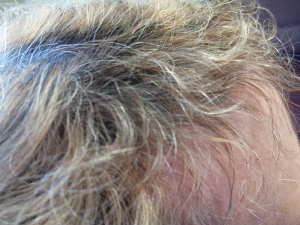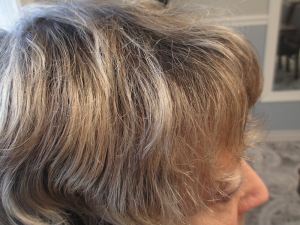Hair loss affects more than 40 percent of American women; problem may be more than an appearance issue, experts say
By Deborah Jeanne Sergeant

Many men with thinning hair shave their heads or just accept thinning hair as part of middle age.
For women, the social stigma surrounding hair thinning and hair loss can make the experience emotionally devastating.
Forty percent of Americans with hair loss are women, according to the American Hair Loss Association. For most of them, it’s overall thinning, not the horseshoe-shaped pattern of baldness common to men with male pattern baldness.
Nicole Capria, hair replacement technician with Profiles by Kristin in Syracuse, said that most women with thinning hair think they need a complete hair replacement, such as a wig.
“They don’t know what’s available,” Capria said. “We do an analysis during a one-on-one consultation to determine what they’re a candidate for. We determine if the client would have success with that method.”
Her office provides scalp treatments, laser treatments, supplements, hair replacements, hair extensions, and wigs for women. Hair restoration for women in Nashville TN is also a great option for women who have hair thinning problems.
“We’re affiliated with several doctors, so we can make referrals,” Capria said.
 She suggests women seek medical help to rule out any health issues.
She suggests women seek medical help to rule out any health issues.
Causes of hair loss could include physical stress, eating disorders, childbirth, thyroid, anemia, poly-cystic ovary syndrome, weight fluctuations, psoriasis or autoimmune or hormonal disorders. Discussing these possible factors could help find ways to decrease shedding.
Jeanine Stevenson, partner at Genesis II Hair Replacement Studio in North Syracuse, encourages patients to see a doctor to explore a medical possibility for their hair loss. Some types of medication may cause thinning. Asking about alternatives could help slow shedding and restore what was lost. If you have dreadlocks, you can read more on how to maintain locs at lionlocs.com.
At her office, Stevenson begins her private consultation with a medical history and scalp analysis. Stevenson also discusses nutrition.
“Everything in our body, including our scalp, needs oxygen and nutrients,” Stevenson said. “When breastfeeding or having a medical issue, the body will distribute nutrients elsewhere and the first place it pulls it from is the hair.”
 Androgenetic alopecia, commonly called female pattern hair loss, involves thinning on the top of the head. Women may notice their part seems wider than it used to. Usually, this happens gradually; however, an abrupt case can indicate a hormonal change.
Androgenetic alopecia, commonly called female pattern hair loss, involves thinning on the top of the head. Women may notice their part seems wider than it used to. Usually, this happens gradually; however, an abrupt case can indicate a hormonal change.
For the right candidates, she recommends all-natural alternatives to monoxodil.
“If she’s in the more severe stage and the last chance for it should grow, I’ll go for something with monoxidil,” Stevenson said.
Another option to help those with female pattern hair loss is cold light-based laser technology, delivered with a comb or cap to stimulate re-growth.
“It stimulates blood flow and opens up the scalp to get oxygen it needs,” Stevenson said. “The laser you can use in the privacy of your home. They get significant results. I have before and after pictures. It’s amazing.”
In addition to laser therapy, Stevenson’s office also offers blood platelet injections, which involve a patient’s own blood cells injected into the scalp skin to stimulate growth.
“It has been proven to grow hair,” Stevenson said. “It’s a boost of nutrients into the scalp. You receive simple injections and it’s your platelet rich plasma only. There’s no chance of a reaction.” When doing PRP therapy injections like PRP therapy in El Paso, TX, they do it along with hair loss control products, so it’s a multi-faceted approach.
Alopecia areata, an autoimmune disease, causes patchy hair loss on the head. Alopecia totalis bares the entire head and alopecia universalis causes all of the body’s hair to fall out. Some people see patchy re-growth and even times of remission with substantial re-growth. Patchy hair loss of alopecia is often treated with steroid injections into the places missing hair.
Stevenson’s office provides hair transplantation of the clients’ own hair from a donor site where hair is thicker.
Genesis II also fits clients with hairpieces made of human hair, ranging from partial to full coverage, with temporary, semi-permanent and permanent bonding.
Permanent models are bonded to existing hair, similar to how hair extensions are applied. Prosthetic adhesives ensure they cannot come off. Semi-permanent pieces are removed every three to six weeks for servicing and temporary ones may be removed by clients at home.
Genesis II can affix hair extensions, which can enhance the fullness of thin hair while also remaining undetectable.
Stevenson urges women to “do their homework and research because everyone out there will tell you they have something that will help. You have to be the right candidate for these products.”
Treatments or a hair restoration procedure started at the earliest signs of thinning also tend to work better.
“We help you through it,” Stevenson said. “When you see it working, it’s wonderful. Women don’t have to suffer from hair loss.”
